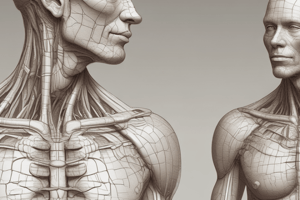Podcast
Questions and Answers
What is a significant characteristic of a macule?
What is a significant characteristic of a macule?
- It is a superficial pale swelling with surrounding erythema.
- It is a flat discoloration less than 1cm. (correct)
- It is a collection of free fluid larger than 1cm.
- It is an elevated solid lesion larger than 1cm.
Which skin lesion is characterized by the loss of both dermis and epidermis and heals with scarring?
Which skin lesion is characterized by the loss of both dermis and epidermis and heals with scarring?
- Ulcer (correct)
- Fissure
- Erosion
- Scale
What type of skin appendage are eccrine glands primarily involved in?
What type of skin appendage are eccrine glands primarily involved in?
- Sebaceous oil production
- Pheromone release
- Thermoregulation (correct)
- Hair follicle secretion
Which of the following is true regarding necrobiosis lipoidica?
Which of the following is true regarding necrobiosis lipoidica?
In which area of the body are apocrine glands primarily found?
In which area of the body are apocrine glands primarily found?
What is a common feature of lichenification?
What is a common feature of lichenification?
Which skin condition is primarily characterized by a dilated opening of the pilosebaceous duct?
Which skin condition is primarily characterized by a dilated opening of the pilosebaceous duct?
What describes a fissure in terms of skin lesions?
What describes a fissure in terms of skin lesions?
What is the defining feature of a pustule?
What is the defining feature of a pustule?
What is the primary function of sebaceous glands?
What is the primary function of sebaceous glands?
Flashcards
Merkel cell
Merkel cell
A mechanoreceptor in the skin that detects light touch.
Eccrine sweat gland
Eccrine sweat gland
A sweat gland that regulates body temperature, primarily found in palms and soles.
Apocrine sweat gland
Apocrine sweat gland
A sweat gland that starts functioning at puberty and is found in the axilla and inguinal region.
Sebaceous gland
Sebaceous gland
Signup and view all the flashcards
Macule
Macule
Signup and view all the flashcards
Papule
Papule
Signup and view all the flashcards
Vesicle
Vesicle
Signup and view all the flashcards
Scale (skin lesion)
Scale (skin lesion)
Signup and view all the flashcards
Necrobiosis lipoidica
Necrobiosis lipoidica
Signup and view all the flashcards
Comedone
Comedone
Signup and view all the flashcards
Study Notes
Merkel Cells
- Merkel cells are mechanoreceptors responsible for light touch
- Eccrine glands regulate thermoregulation, mostly found in palms and soles
- Apocrine glands begin functioning at puberty, in axillary and inguinal regions, associated with the pilosebaceous apparatuses
- Sebaceous glands present throughout the body, excluding palms and soles
- Macule: flat discoloration less than 1 cm
- Patch: flat discoloration greater than 1 cm
- Papule: elevated solid lesion less than 1 cm, can merge into plaques
- Plaque: elevated solid lesion greater than 1 cm
- Nodule: elevated solid lesion with depth, a large nodule might be considered a tumor
- Vesicle: collection of free fluid less than 1 cm
- Bulla: collection of free fluid greater than 1 cm
- Pustule: collection of pus with free fluid
- Wheal: superficial, pale swelling, surrounded by erythema, lasting less than 24 hours, seen in urticaria
- Scale: excess dead epidermal cells due to abnormal keratinization and shedding
- Crust(scab): collection of dried serum and cellular debris
- Erosion: focal loss of epidermis, heals without scars
- Ulcer: focal loss of dermis and epidermis, heals with scars
- Fissure: linear loss of dermis and epidermis, sharp edges
- Scar: abnormal formation of connective tissue after injury or surgery, can be atrophic or hypertrophic
Diagnostic Skin Lesions
- Excoriation: linear erosion caused by scratching
- Comedone (blackhead): dilated opening of pilosebaceous duct, hypercornification
- Closed comedone: narrow opening
- Acne: milia, small keratin cysts without openings
- Cyst: circumscribed lesion with a lumen
- Petechiae: blood deposit less than 1 cm
- Purpura: blood deposit larger than 1 cm
- Burrow (tunnel): narrow, winding channel from parasites like Sarcoptes scabiei (scabies)
- Lichenification: thickened epidermis from scratching, accentuated skin lines
- Telangiectasia: dilated superficial blood vessels
Cutaneous Manifestations of Systemic Diseases
- Diabetes Mellitus
- 30% develop skin disorders
- Necrobiosis lipoidica
- Granuloma annulare
- Acrochordons
- Necrobiosis Lipoidica
- 75-1% of patients have or will develop DM
- Occurs on the anterior lower leg
- Oval, slow-expanding patch with red border, central atrophy/ulceration possible
- Small risk of squamous cell carcinoma
Granuloma Annulare
- 12% of patients with GA have DM, chronic relapsing GA
- Can be generalized or localized, affecting the hands and feet
- Skin-colored papules, undergoing central regression, forming rings
Dyslipoproteinemia and Xanthomas
- Lipid deposits in skin and tendons (xanthomas)
- Xanthelasma: most common form, eyelids
- Eruptive xanthoma: indication of hypertriglyceridemia; papules on buttocks and limbs
- Plane xanthomas: palmar creases
- Tuberous xanthomas: elbows, knees
- Tendinous xanthomas: tendons on elbows/knees, Achilles tendon, persistent
- Neurofibromatosis
- Skin, CNS, eyes, bones
- Hamarmatou tumors surrounding nerves
- NF-1: most common
- NF-2: bilateral acoustic neuroma + other tumors
- NF-5: segmental
NF-1 Criteria
- 7 criteria, satisfying 2 sufficient for diagnosis
- Café au lait macules
- Neurofibromas
- Axillary freckling
- Lisch nodules (melanocytic hamartomata)
- Optic glioma
- Osseous lesions
- 1st degree relative with NF-1
- High lifetime malignancy risk
Studying That Suits You
Use AI to generate personalized quizzes and flashcards to suit your learning preferences.



